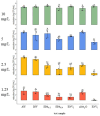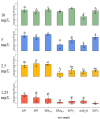Chlorine dioxide is a broad-spectrum disinfectant against Shiga toxin-producing Escherichia coli and Listeria monocytogenes in agricultural water
- PMID: 39526135
- PMCID: PMC11543455
- DOI: 10.3389/fmicb.2024.1469615
Chlorine dioxide is a broad-spectrum disinfectant against Shiga toxin-producing Escherichia coli and Listeria monocytogenes in agricultural water
Abstract
Agricultural water is commonly treated with chlorine-based disinfectants, which are impacted by water quality. Understanding how water quality influences disinfectants such as chlorine dioxide (ClO2) against pathogenic bacteria is important for creating efficacious sanitation regimens. In this study, the minimum inhibitory concentration (MIC) of ClO2 needed to achieve a 3-Log reduction against Shiga toxin-producing Escherichia coli (STEC) and Listeria monocytogenes was compared across agricultural water samples. Sterile ddH2O served as a control to compare with environmental samples from Salinas Valley, CA, and laboratory standards. To test different dosages and water qualities, stock ClO2 was diluted in 24-well plates with target concentrations of 10, 5, 2.5, and 1.25 mg/L. Well plates were inoculated with pathogens and treated with sanitizer for 5 min. Following treatment, surviving pathogens were enumerated using viable cell counts. The results demonstrate that groundwater samples had the highest water quality of the environmental samples and required the lowest concentration of disinfectant to achieve 3-Log reduction against both bacteria, with MIC between 1.4 and 2.0 mg/L. Open-source samples had lower water quality and required a higher concentration of ClO2 for 3-Log reduction, with MIC between 2.8 and 5.8 mg/L for both pathogens. There was no correlation between pH, turbidity, or conductivity/TDS and reduction for either STEC or L. monocytogenes, suggesting no individual water metric was driving reduction. A lower dosage was required to achieve 3-Log reduction against STEC, while L. monocytogenes required greater concentrations to achieve the same level of reduction. Overall, these results help guide growers in using ClO2 as a broad-spectrum disinfectant and demonstrate its efficacy in reaching 3-Log reduction across agricultural water samples.
Keywords: Escherichia coli; Listeria monocytogenes; agricultural water; chlorine dioxide; minimum inhibitory concentration; water treatment.
Copyright © 2024 Van Blair, Lacombe, Harvey and Wu.
Conflict of interest statement
The authors declare that the research was conducted in the absence of any commercial or financial relationships that could be construed as a potential conflict of interest.
Figures





Similar articles
-
Effectiveness of Aqueous Chlorine Dioxide in Minimizing Food Safety Risk Associated with Salmonella, E. coli O157:H7, and Listeria monocytogenes on Sweet Potatoes.Foods. 2020 Sep 8;9(9):1259. doi: 10.3390/foods9091259. Foods. 2020. PMID: 32911767 Free PMC article.
-
Impact of chlorine or peracetic acid on inactivation of Salmonella, Escherichia coli, and Listeria monocytogenes in agricultural water.Sci Total Environ. 2023 Aug 10;885:163884. doi: 10.1016/j.scitotenv.2023.163884. Epub 2023 May 3. Sci Total Environ. 2023. PMID: 37142011
-
Combination treatment of chlorine dioxide gas and aerosolized sanitizer for inactivating foodborne pathogens on spinach leaves and tomatoes.Int J Food Microbiol. 2015 Aug 17;207:103-8. doi: 10.1016/j.ijfoodmicro.2015.04.044. Epub 2015 May 2. Int J Food Microbiol. 2015. PMID: 26001524
-
Kinetics and Mechanisms of Virus Inactivation by Chlorine Dioxide in Water Treatment: A Review.Bull Environ Contam Toxicol. 2021 Apr;106(4):560-567. doi: 10.1007/s00128-021-03137-3. Epub 2021 Feb 25. Bull Environ Contam Toxicol. 2021. PMID: 33629148 Free PMC article. Review.
-
Aqueous chlorine dioxide treatment of horticultural produce: Effects on microbial safety and produce quality-A review.Crit Rev Food Sci Nutr. 2018 Jan 22;58(2):318-333. doi: 10.1080/10408398.2016.1169157. Epub 2017 Jun 28. Crit Rev Food Sci Nutr. 2018. PMID: 27196114 Review.
References
-
- Bhullar M. S., Shaw A., Mendonca A., Monge A., Nabwire L., Thomas-Popo E., et al. (2021). Toxin–producing Escherichia coli in the long-term survival phase exhibit higher chlorine tolerance and less sublethal injury following chlorine treatment of romaine lettuce. Foodborne Pathog. Dis. 18 276–282. - PubMed
LinkOut - more resources
Full Text Sources
Molecular Biology Databases
Research Materials

